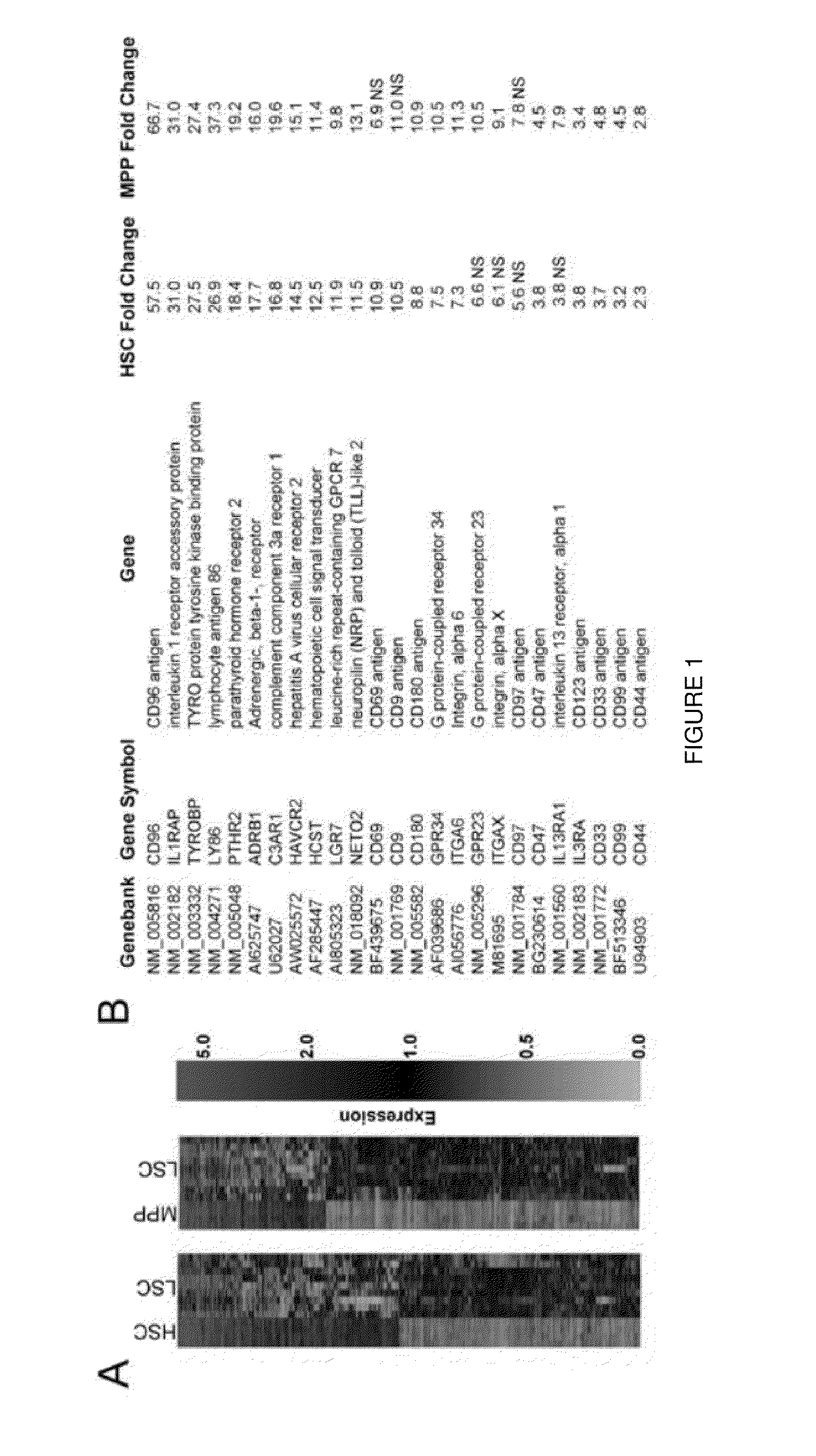Ex vivo methods for targeting or depleting acute myeloid leukemia cancer stem cells
a myeloid leukemia and stem cell technology, applied in the field of ex vivo methods for targeting or depleting acute myeloid leukemia cancer stem cells, can solve problems such as metastatic diseas
- Summary
- Abstract
- Description
- Claims
- Application Information
AI Technical Summary
Problems solved by technology
Method used
Image
Examples
example 1
Identification of Cell Surface Molecules Preferentially Expressed on Human Acute Myeloid Leukemia Stem Cells Compared to their Normal Counterparts
[0142]Prospective Identification of a Human Multipotent Progenitor, the Cell of Origin for AML LSC. Identification of cell surface molecules that are preferentially expressed on AML LSC would be greatly facilitated by determining the cell within the normal hematopoietic hierarchy that undergoes transformation to become an AML LSC. The prevailing view in the field has been that AML LSC arise out of hematopoietic stem cells (HSC), since both stem cell populations are enriched in Lin-CD34+CD38− cells. However, human HSC have been shown to express CD90, while AML LSC are CD90−. Furthermore, HSC from long-term remission t(8; 21) AML patients were found to contain the AML1-ETO translocation product, suggesting that the HSC were pre-leukemic, and that full transformation to AML LSC occurred in a downstream progenitor.
[0143]While it is certainly p...
example 2
[0159]CD99 is a surface glycoprotein with highest expression on T cells where it may function in cellular adhesion. CD99 expression on HSC (Lin-CD34+CD38−CD90+) from three samples of normal human cord blood and AML LSC (Lin-CD34+CD38−CD90−) from seven samples of human AML was determined by flow cytometry (FIG. 6). CD99 was expressed at low levels on the surface of normal HSC; however, on average, it is approximately 5-fold more highly expressed on AML LSC. CD97 is normally expressed on most mature hematopoietic cells and is upregulated on activated lymphocytes where it may function in cellular migration and adhesion. Gene expression profiling indicates low to absent expression of CD97 in HSC and MPP, with approximately 10-fold higher expression in AML LSC. CD97 expression on normal cord blood HSC and AML LSC was examined by flow cytometry and found to be absent on HSC and high on 5 out of 7 AML LSC samples (FIG. 7).
[0160]We examined the surface expression of CD97, CD99, CD180, and T...
example 3
Prospective Separation of Normal and Leukemic Stem Cells Based on Differential Expression of TIM-3, a Novel Human AML Stem Cell Marker
[0161]Hematopoietic tissues in acute myeloid leukemia (AML) patients contain both leukemia stem cells (LSC) and residual normal hematopoietic stem cells (HSC). The ability to prospectively separate residual HSC from LSC facilitates scientific and clinical investigation, including purging for autologous hematopoietic cell transplants. We report here the identification of TIM-3 as a novel AML stem cell surface marker that is highly expressed on multiple specimens of AML LSC, but not on normal bone marrow HSC. TIM-3 expression was detected in all cytogenetic subgroups of AML, but was significantly higher in AML-associated with core binding factor translocations or mutations in CEBPA. By assessing engraftment in NOD / SCID / IL2Rγ-null mice, we determined that normal bone marrow HSC do not express TIM-3, whereas LSC from multiple AML specimens express high le...
PUM
| Property | Measurement | Unit |
|---|---|---|
| time | aaaaa | aaaaa |
| volume | aaaaa | aaaaa |
| heterogeneity | aaaaa | aaaaa |
Abstract
Description
Claims
Application Information
 Login to View More
Login to View More - R&D
- Intellectual Property
- Life Sciences
- Materials
- Tech Scout
- Unparalleled Data Quality
- Higher Quality Content
- 60% Fewer Hallucinations
Browse by: Latest US Patents, China's latest patents, Technical Efficacy Thesaurus, Application Domain, Technology Topic, Popular Technical Reports.
© 2025 PatSnap. All rights reserved.Legal|Privacy policy|Modern Slavery Act Transparency Statement|Sitemap|About US| Contact US: help@patsnap.com



